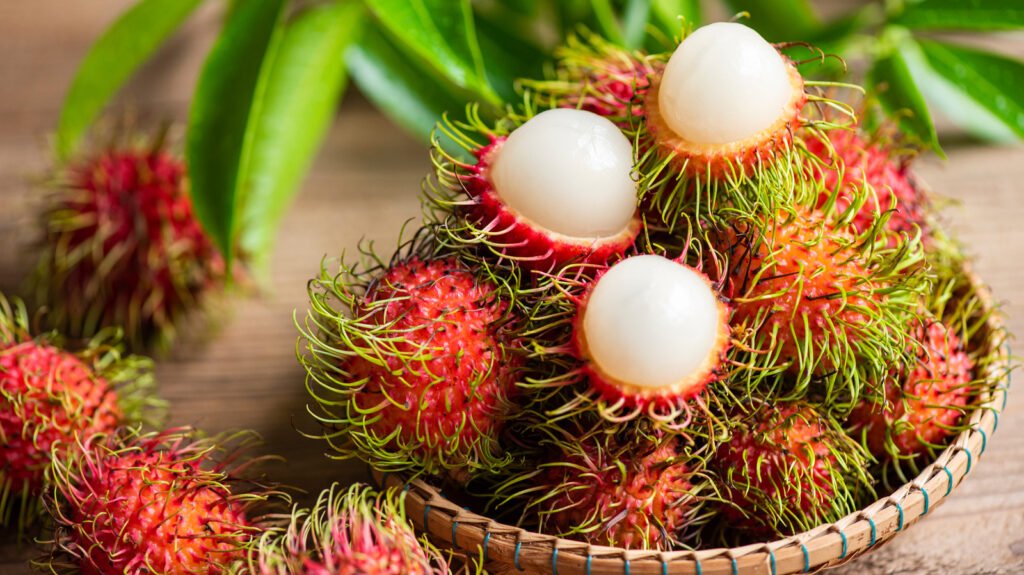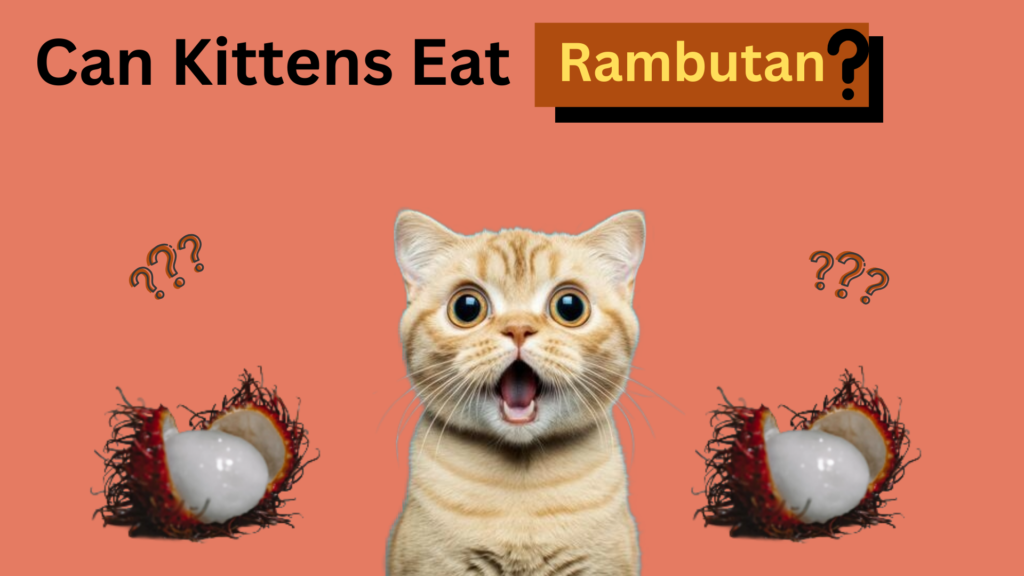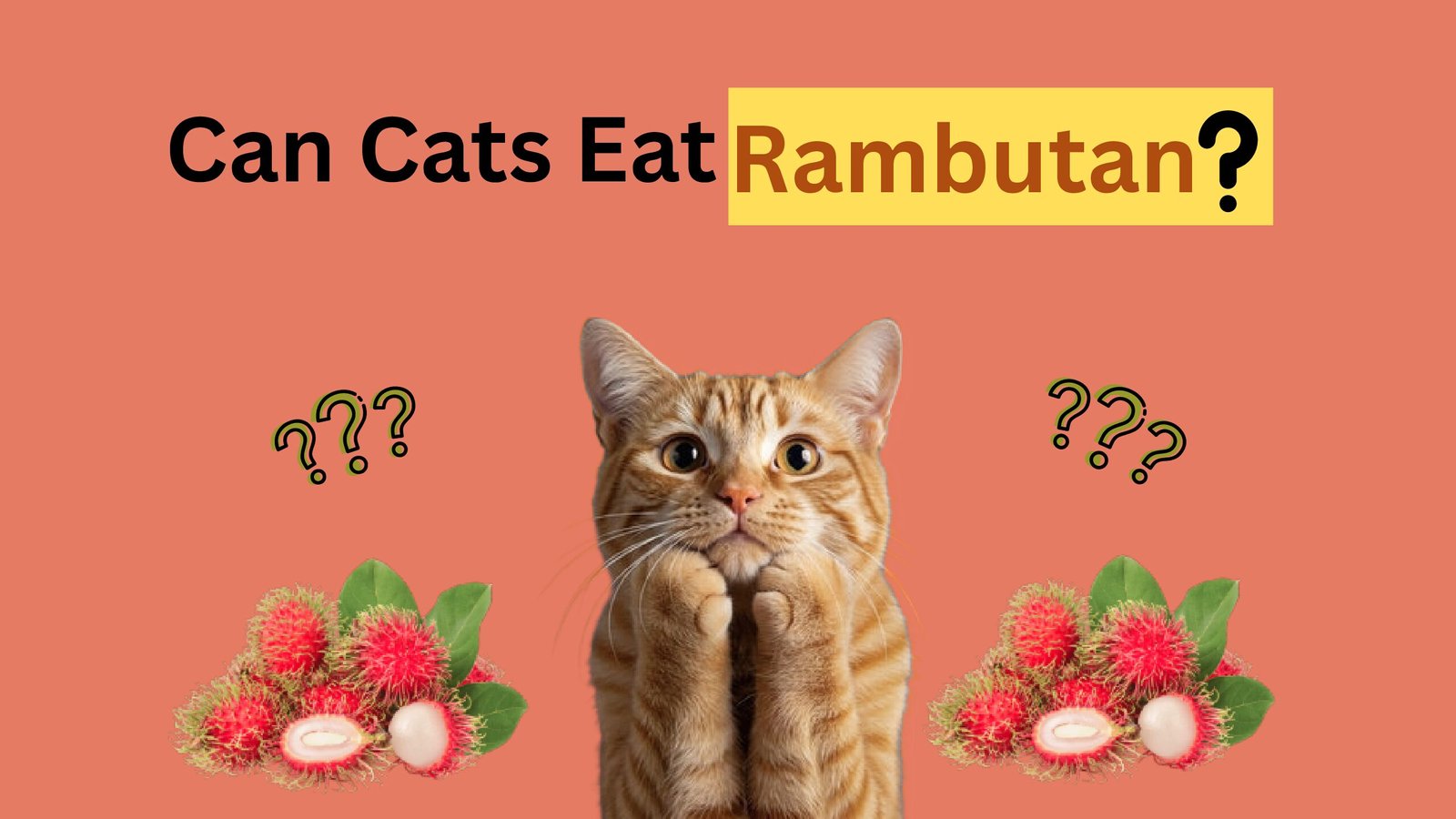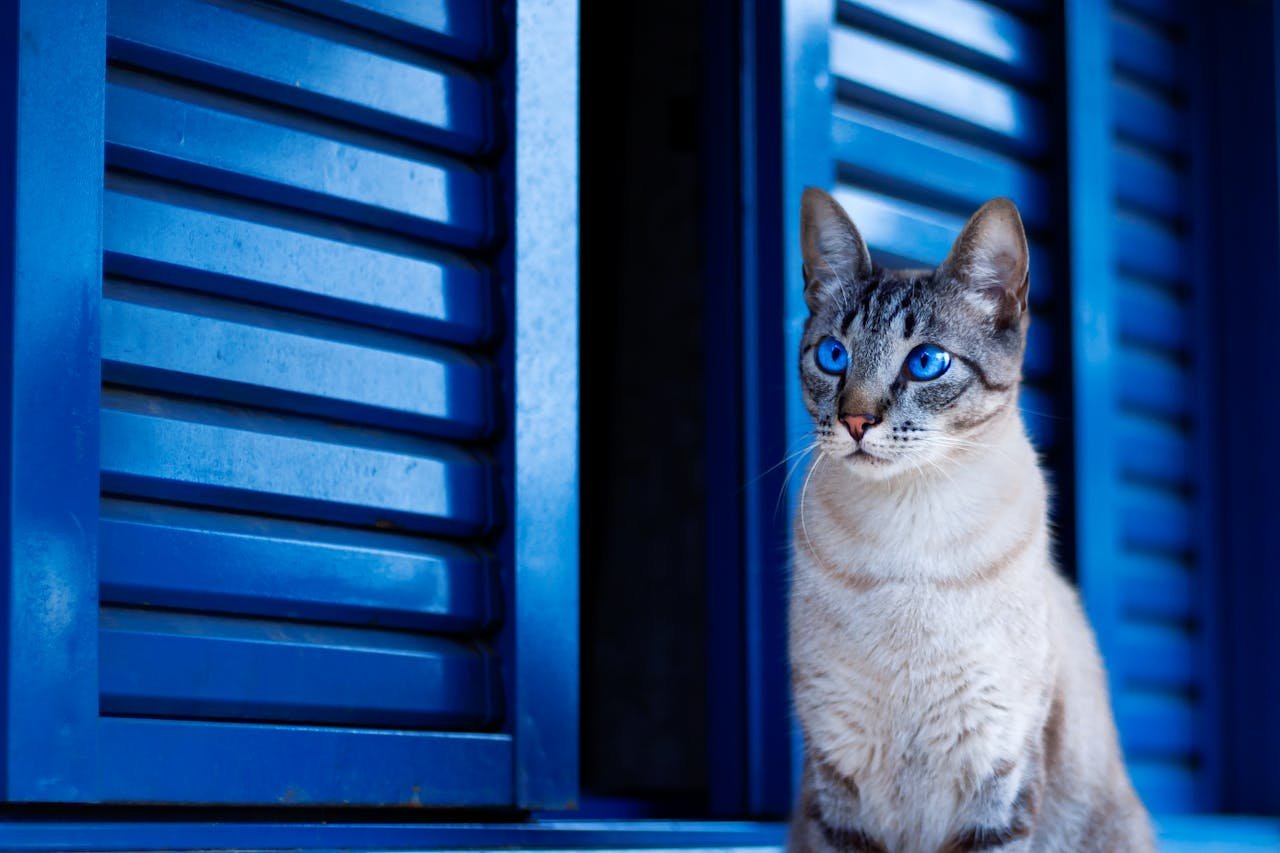Can Cats Eat Rambutan? Everything Cat Owners Should Know in 2025

If you’re a cat owner who enjoys tropical fruits, you might wonder: Can cats eat rambutan? The simple answer is no. Rambutan may look soft and juicy, but it isn’t safe for cats. As obligate carnivores, cats need a meat-based diet to stay healthy, not sugary fruits. Rambutan contains high sugar levels and a large seed that can upset your cat’s stomach, cause vomiting, diarrhea, or even lead to choking. While it may seem harmless to share a small bite, this fruit offers no nutritional benefits and may trigger digestive problems instead. Some fruits are safe for pets in moderation, but rambutan is not one of them. If your cat accidentally eats a small piece, monitor them closely and contact your vet if symptoms appear. The best way to care for your furry friend is by sticking to safe, protein-rich foods and avoiding risky fruits like rambutan.
What Is Rambutan Fruit? A Closer Look for Cat Owners
Rambutan is a tropical fruit that thrives in warm, humid climates across Southeast Asia and other tropical regions. Recognized by its unusual appearance, the fruit has a spiky, hair-like skin that ranges from bright red to yellow. Once peeled, it reveals a translucent white flesh with a sweet, juicy taste that many compare to lychee or grapes. At its core lies a large seed, which is not safe to consume. While rambutan is a refreshing and healthy snack for humans, it is not designed for animals—especially cats—since their digestive systems cannot handle the sugars and seed safely.
Can Cats Eat Rambutan Safely?
The clear answer is no, cats cannot eat rambutan safely. This tropical fruit may be refreshing and delicious for humans, but it is not designed for a cat’s delicate digestive system. As obligate carnivores, cats need animal protein to stay healthy, not sugary fruits. Rambutan contains natural sugars that can easily upset your cat’s stomach, leading to vomiting, diarrhea, or discomfort. The large seed inside is even more dangerous—it can cause choking, intestinal blockage, or even poisoning if chewed. Unlike humans, cats receive no nutritional benefit from rambutan, which means offering it only exposes them to unnecessary risks. If you have ever asked yourself, “Can cats eat rambutan safely?”, the answer is always no. Instead, choose protein-rich foods and vet-approved treats that actually support your cat’s well-being.
Many pet owners also wonder: “Is rambutan safe for cats in small amounts?” The truth is that all parts of the fruit pose risks.
- The outer skin is rough and sharp, and if a cat tries to chew it, it may cause cuts in the mouth or stomach irritation.
- The seed is large, slippery, and toxic—making it a serious choking hazard or potential cause of blockage.
- The flesh may look harmless, but its high sugar content is difficult for cats to process and can trigger digestive problems.
While rambutan may look fun, colorful, and tasty to us, it is not a safe choice for cats. What’s healthy for humans isn’t always safe for pets, and rambutan is a clear example of that. If you want to share a treat with your feline friend, stick to safe alternatives like cooked chicken, catnip, or vet-approved snacks instead of experimenting with risky fruits.
Can Cats Eat Rambutan? Potential Benefits
While rambutan is not an ideal food for cats, a few minor benefits may exist if a cat accidentally consumes a tiny piece of the flesh (without the peel or seed). These benefits, however, are minimal and never outweigh the risks. Still, here’s what the fruit may offer:
- Hydration Support
Rambutan flesh has a naturally high water content. In rare cases, this could provide a small hydration boost, especially for cats that don’t drink enough water on their own. - Trace Vitamin C
Rambutan contains small amounts of vitamin C. While cats naturally produce this vitamin in their liver and don’t require it from food, the tiny traces may still support overall wellness on a very minimal level. - Mild Fiber Content
In carefully prepared, seedless pieces, rambutan flesh contains dietary fiber. This could, in theory, aid digestion. However, too much fiber can cause the opposite effect, such as bloating or diarrhea.
Important Note: These “benefits” are not reasons to add rambutan to your cat’s diet. Cats are obligate carnivores, and their true nutritional needs come from meat-based proteins and fats, not sugary tropical fruits. Rambutan should never be treated as a regular snack for felines.
Why Rambutan Is Not Recommended for Cats
Although rambutan may look harmless, it carries several risks for cats. Here’s a closer look at why this tropical fruit should never be part of your feline’s diet:
Related Post: Can Cats Eat Pepperoni? Expert Safety Tips & Facts 2025
High Sugar Content
Cats are obligate carnivores, which means their bodies are not designed to process fruit sugars.
- Natural sugars in rambutan can upset your cat’s stomach.
- Regular sugar intake may lead to obesity, diabetes, and long-term health issues.
- Cats cannot taste sweetness, so rambutan offers no enjoyment or benefit to them.
Choking Hazard from Seed
The large seed inside rambutan is one of its most dangerous parts.
- It can easily get stuck in your cat’s throat, causing choking.
- If swallowed, it may block the intestines and require emergency surgery.
- Some compounds in the seed are considered toxic, making it unsafe even in small amounts.
Digestive Upset Risks
Even a small bite of rambutan flesh can disturb your cat’s digestive system.
- Common symptoms include vomiting, diarrhea, and stomach cramps.
- Excess sugar can cause dehydration and lethargy.
- Sensitive cats may react more severely, needing veterinary care.
No Nutritional Benefits for Cats
Rambutan may be healthy for humans, but it has nothing valuable for cats.
- Cats need animal protein, taurine, and amino acids to stay healthy.
- Fruits like rambutan provide no essential nutrients for feline health.
- Feeding it only replaces the foods that actually help your cat thrive.
What Happens If a Cat Eats Rambutan?
If your cat manages to sneak a bite of rambutan, the outcome depends on which part of the fruit it eats. While a tiny amount of the flesh may not cause immediate danger, rambutan is still risky and should never be considered safe for felines.
Here’s what you need to know:

1. If Your Cat Eats the Flesh
- Mild digestive upset — vomiting, diarrhea, or stomach discomfort.
- Excessive drooling or lip-licking — a sign that the taste or sugar is irritating.
- Lethargy — cats may appear weak or unusually tired after eating sweet fruit.
Even if symptoms seem minor, remember that cats cannot properly process sugar, and repeated exposure may harm their health long-term,
2. If Your Cat Eats the Seed or Skin
This is far more dangerous than eating the flesh.
- Choking hazard — the seed can get stuck in your cat’s throat.
- Intestinal blockage — if swallowed, it may block the digestive tract, requiring emergency surgery.
- Toxic risk — the seed and skin contain compounds unsafe for cats.
Emergency Tip: If your cat eats the rambutan seed or skin, contact your veterinarian immediately. Do not wait for symptoms to worsen.
3. What You Should Do as an Owner
- Monitor your cat closely for the next several hours.
- Provide fresh water to prevent dehydration from vomiting or diarrhea.
- Call your vet right away if you notice severe symptoms like continuous vomiting, bloated stomach, or difficulty breathing
Can Cats Eat Rambutan? Potential Risks
Rambutan may be a refreshing snack for humans, but it poses several rambutan danger and health risks for cats. Here are the key concerns every cat owner should know:
1. Choking Hazard
The large, slippery seed inside rambutan can easily get stuck in a cat’s throat or cause an intestinal blockage, which may require emergency surgery.
2. Toxic Seed Compounds
Rambutan seeds may contain natural toxins or alkaloids that are unsafe for cats if ingested, putting their overall health at serious risk.
3. High Sugar Content
The sweet flesh of rambutan is loaded with natural sugars that cats cannot process well. Regular intake can lead to stomach upset, obesity, dental problems, or even diabetes in the long run.
4. Allergic Reactions & Digestive Upset
Since cats are obligate carnivores, introducing unfamiliar fruits like rambutan can cause vomiting, diarrhea, lethargy, or allergic reactions in sensitive felines.
Is Rambutan Poisonous to Cats?
Yes — the rambutan seed is poisonous to cats. It contains toxic compounds that can irritate your cat’s digestive system and, in severe cases, damage vital organs like the liver. The skin is not directly toxic, but its hairy texture can irritate the stomach and even cause dangerous intestinal blockages.
The flesh itself isn’t toxic, but it’s high in natural sugar, which can trigger obesity, diabetes, or stomach upset in cats. What may look like a harmless tropical treat actually carries more risks than benefits for your feline friend.
The safest choice is complete avoidance. Never let your cat sniff, lick, or nibble rambutan. Always dispose of the seed and skin in a sealed trash bin where curious pets cannot reach them.
2025 Cat-Safety Insight: With pet wellness awareness at an all-time high, experts emphasize that cats—being obligate carnivores—do not need sugary or exotic fruits. Even “non-toxic” fruits may lead to long-term health complications. Pet parents are now encouraged to stick to vet-approved cat treats and avoid experimenting with tropical fruits like rambutan.
Why Cats Should Not Eat Rambutan Often
Even if your cat eats a small piece of rambutan and looks fine afterward, it doesn’t mean it’s safe to offer again. Rambutan contains excess sugar, which can lead to weight gain, obesity, and even diabetes in cats. Beyond that, it provides no meaningful nutrition for your feline. Repeated feeding may also encourage your cat to beg for or expect human food regularly, which disrupts their natural diet. Since cats are obligate carnivores, they require protein-rich meals designed specifically for them — not sugary fruits.

Rambutan, with its juicy flesh and hairy red shell, may look harmless to humans, but for cats, it carries hidden dangers. While the fruit flesh itself is not directly toxic, the seed, skin, and high sugar levels can trigger health problems. For this reason, it’s best to keep rambutan and other sweet fruits off your cat’s plate to protect their long-term health.
Emergency Tips if Your Cat Eats Rambutan
If your curious cat has managed to sneak a bite of rambutan, stay calm but act wisely. Even though the fruit itself isn’t highly toxic, the seed, peel, and excess sugar can cause serious problems. Here are essential steps every cat owner should follow:
- Check What Part Was Eaten
Identify whether your cat consumed just the flesh or also swallowed the peel or seed. The seed and hairy peel are the most dangerous parts. - Remove Any Remaining Rambutan
Take away any leftover fruit immediately so your cat doesn’t eat more. Dispose of the peel and seed securely.
Monitor for Symptoms
Watch your cat closely for signs like vomiting, diarrhea, choking, lethargy, bloating, or loss of appetite. These may appear within hours. - Do Not Try Home Remedies
Avoid forcing your cat to vomit or giving over-the-counter medicines. This may cause more harm than good. - Provide Fresh Water
Encourage your cat to drink water to help flush out any sugars or mild irritants from its system. - Contact Your Veterinarian
If your cat ate the seed, peel, or a large amount of rambutan, call your vet right away. Immediate professional advice can prevent complications such as intestinal blockage. - Emergency Vet Visit
If your cat shows severe symptoms like difficulty breathing, repeated vomiting, or collapse, rush to the nearest veterinary clinic without delay.
Important Reminder: Cats are obligate carnivores, and fruits like rambutan add more risks than benefits. Prevention is always better than cure—so keep exotic fruits safely out of your cat’s reach.
Safe Fruits for Cats to Eat Instead of Rambutan
While rambutan may not be safe for cats, there are a few fruits that can be offered in tiny, occasional amounts as healthier alternatives. Cats are obligate carnivores, meaning they don’t need fruit in their diet — but if you want to share a refreshing treat once in a while, the following options are considered safer:
- Blueberries – Rich in antioxidants and low in sugar, blueberries are one of the best fruits cats can occasionally nibble.
- Watermelon (seedless, flesh only) – Packed with water, this fruit helps with hydration during hot days.
- Bananas (tiny slices only) – A natural source of potassium, though only safe in moderation due to higher sugar content.
How to Safely Feed Fruits to Cats
- Always remove seeds, peels, and rinds before giving fruit to your cat.
- Offer only a single bite-sized piece and monitor your cat’s reaction.
- Stick to fresh fruit only — avoid dried fruit, fruit snacks, or canned fruit as they often contain harmful additives or excessive sugar.
- Never replace your cat’s balanced diet with fruit; treats should make up less than 10% of their total food intake.
- When in doubt, consult your veterinarian before introducing any new food to your cat’s diet.
Can Kittens Eat Rambutan?
Kittens have delicate, developing digestive systems, making them far more vulnerable to foods that adult cats might tolerate in tiny amounts. While adult cats should avoid rambutan, the risks for kittens are significantly higher, and even small amounts can be harmful.

Why Rambutan Is Dangerous for Kittens
- High Sugar & Digestive Sensitivity: Kittens cannot efficiently process sugary foods. Eating rambutan flesh may cause diarrhea, stomach upset, or dehydration.
- Choking Hazard: The rambutan seed is large and slippery. Kittens, with their small throats, are at a higher risk of choking or intestinal blockage if they try to bite or swallow it.
- Growth & Health Impact: Kittens are in a critical growth phase. Even minimal amounts of unfamiliar or sugary foods can interfere with nutrient absorption and overall development.
Do Cats Even Like Rambutan?
Most cats are not naturally attracted to sweet foods. Unlike humans, their taste buds are designed for savory and protein-rich flavors, and they cannot taste sugar. So if your cat shows interest in rambutan, it is usually curiosity rather than appetite.
Common behaviors you may notice:
- Sniffing or pawing at the fruit out of curiosity
- Nibbling or chewing the fruit just for play
- Rarely consuming significant amounts
How to Keep Rambutan Away from Cats
Keeping rambutan and other exotic fruits out of your cat’s reach is essential for their safety and health. Cats are naturally curious, and even a small taste of rambutan can lead to digestive issues, choking, or other health risks. Proper storage, careful handling, and household awareness can prevent accidents.
Practical Tips to Keep Rambutan Away from Cats:
- Store fruits securely: Place all fruits, especially rambutan, in the fridge or a high cupboard where your cat cannot reach.
- Use a lidded fruit bowl: If fruits are left out on the counter, keep them in a covered container.
- Dispose of seeds and peels immediately: After eating rambutan, throw away the seed and skin in a closed trash bin.
- Restrict kitchen access: Keep your cat out of the kitchen when cutting or handling fruits.
- Educate family members and kids: Make sure everyone knows not to feed fruits to your cat, reinforcing safe habits.
Are Cats Allowed to Eat Rambutan? (H2)
Cats should never eat rambutan. This tropical fruit contains high sugar and offers no nutritional benefits for felines.
Why rambutan is unsafe for cats:
- Toxic Seed & Choking Hazard: The large seed can cause choking or intestinal blockage.
- Rough Skin: The hairy exterior can irritate your cat’s mouth or digestive system.
- High Sugar Content: Even the soft flesh can lead to stomach upset, vomiting, or diarrhea.
- Obligate Carnivores: Cats naturally require meat-based nutrition, and their bodies are not designed to process fruits.
What Is a Cat’s Favorite Fruit?
Most cats cannot taste sweetness, so fruits are generally not appealing to them. However, some may enjoy certain textures or scents.
Safe fruit options for cats (in tiny amounts):
- Bananas: Soft texture, low sugar, easy to digest
- Blueberries: Antioxidant-rich and safe in small pieces
- Watermelon (seedless): Hydrating and gentle on the stomach
Related Post: Can Cats Have Mandarin Oranges? Expert Warnings 2025
Which Animals Eat Rambutan?
Rambutan is enjoyed by many wild animals, but not by house pets.
Animals that eat rambutan in the wild:
- Monkeys – peel and eat the soft flesh
- Squirrels – nibble the fruit and seeds
- Birds – enjoy the juicy flesh
These animals have bodies adapted to digest fruits and seeds, unlike domestic cats or dogs.
Final Thoughts: Can Cats Eat Rambutan?
In conclusion, cats should not eat rambutan. While this tropical fruit is sweet and juicy for humans, it offers no nutritional benefits for cats and carries multiple risks. The large seed, hairy skin, and high sugar content can cause choking, digestive upset, or more serious health issues, especially in kittens.
Even if a cat appears curious about rambutan, it is purely exploratory behavior, not a desire or need to consume it. Instead of offering rambutan, focus on protein-rich meals and vet-approved treats to ensure your cat’s diet is safe and balanced.
Important Points to Remember:
- Avoid feeding rambutan entirely to cats and kittens.
- Keep fruits like rambutan out of reach and properly dispose of seeds and peels.
- Offer safe alternatives such as blueberries, bananas, or watermelon in tiny, supervised amounts.
- Monitor your cat if accidental ingestion occurs and consult a vet for any unusual symptoms.
By following these guidelines, you can protect your cat’s health, prevent accidents, and provide safe, nutritious treats that are suitable for obligate carnivores.
Frequently Asked Questions (FAQs) – 2025 Human Search Focus
Can my cat safely eat rambutan?
No, cats cannot safely eat rambutan. The fruit’s sugar, hairy skin, and large seed can cause digestive upset, choking, or serious health issues. Stick to protein-based foods and vet-approved treats.
What happens if a kitten eats rambutan?
Kittens are highly sensitive to sugary or unfamiliar foods. Eating rambutan can lead to vomiting, diarrhea, dehydration, or even choking. Always keep rambutan and other fruits out of reach of kittens.
How should I respond if my cat eats rambutan by accident?
- Small flesh ingestion: Monitor your cat for stomach upset or lethargy.
- Seed or skin ingestion: Contact your vet immediately, as it may cause blockage or poisoning.
Are there any fruits my cat can eat safely?
Yes, in small, supervised portions:
- Blueberries – antioxidant-rich
- Bananas – soft and low sugar
- Seedless watermelon – hydrating and gentle on the stomach
Always remove seeds and skins, and limit portions.
Why can wild animals eat rambutan but cats cannot?
Wild animals like monkeys, squirrels, and birds can safely eat rambutan because their bodies are adapted to process sugar and seeds. Cats, being obligate carnivores, cannot digest these parts and may experience serious health risks.
For More Visits: SiameseMania
Also Read: Can Cats Eat Vegetables? Safe Veggie Guide for Cat

